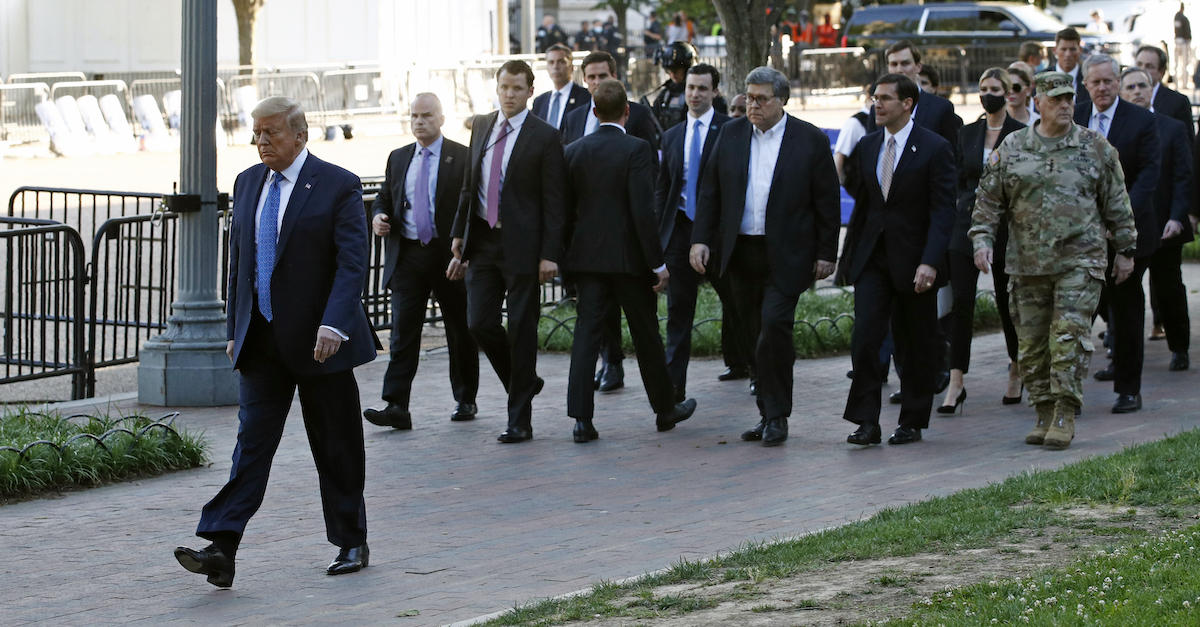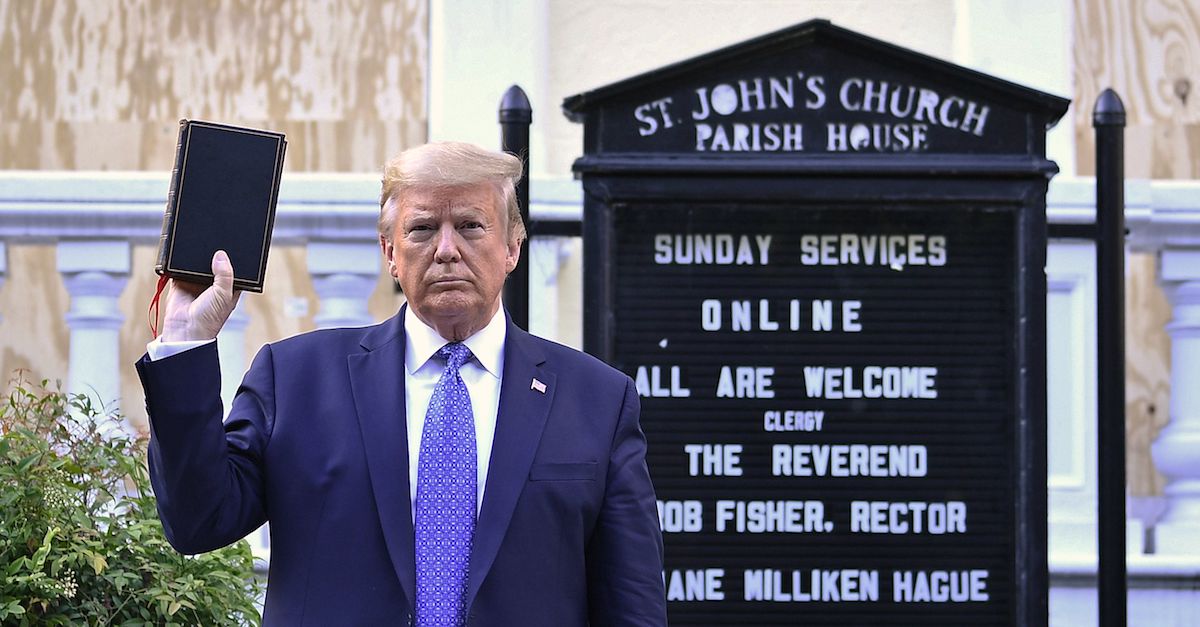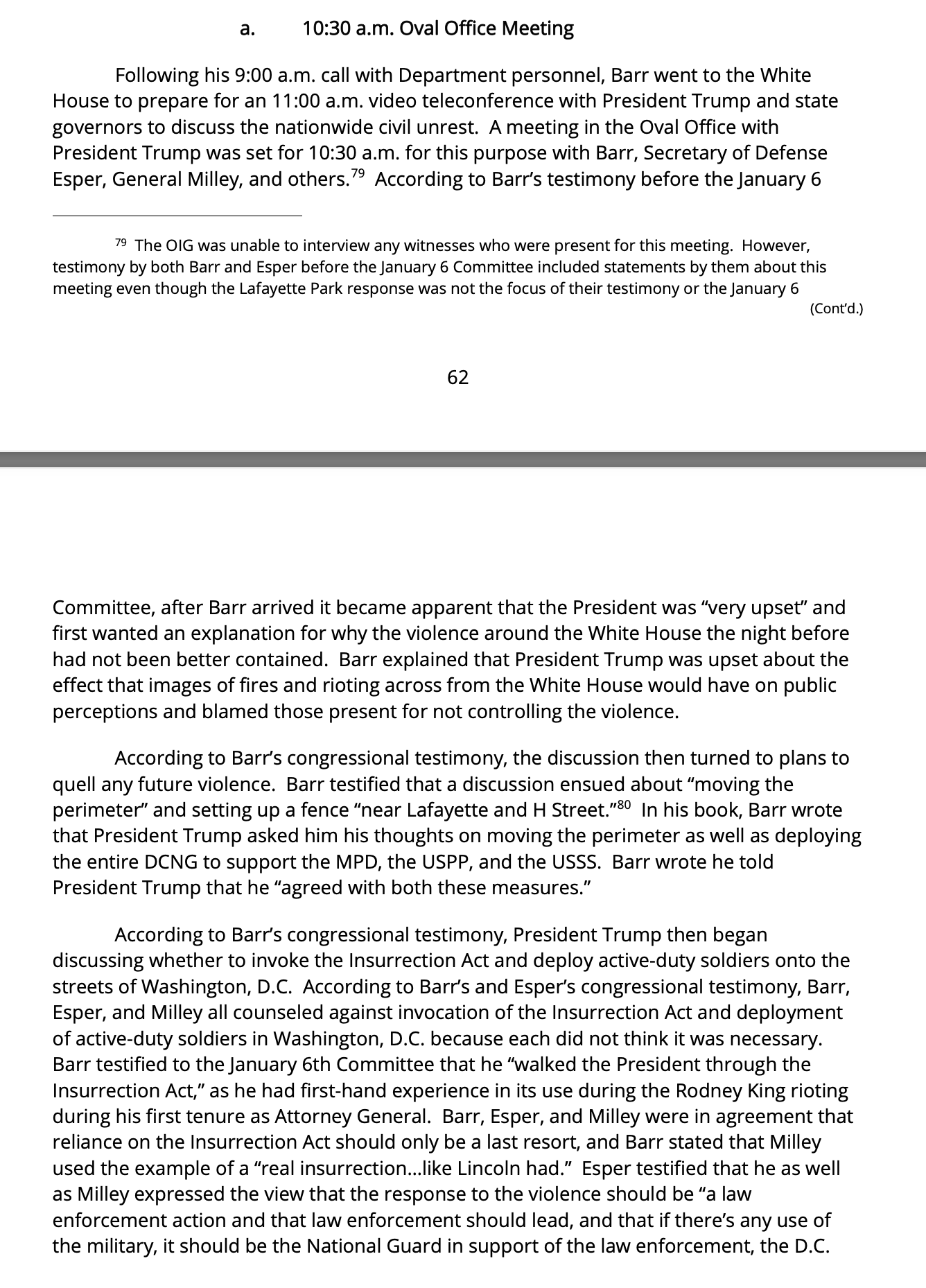

Former President Donald Trump and high-level officials, including Bill Barr, walk in Lafayette Park to visit outside St. John’s Church across from the White House in Washington in June 2020 (AP Photo/Patrick Semansky).
The U.S. Department of Justice’s inspector general has been busy lately releasing reports on episodes from the final months of former President Donald Trump’s term in office, and now the IG has officially completed a review of the DOJ’s role in the quelling of Black Lives Matter protests in Lafayette Park on June 1, 2020, days after the murder of George Floyd and one day after St. John’s Episcopal Church was set on fire.
The incident was already the subject of an Interior Department inspector general report in 2021. That report concluded that U.S. Park Police did not forcefully clear the park just so Trump — flanked by high-level officials, including cabinet members U.S. Attorney General Bill Barr and former Secretary of Defense Mark Esper — could go for a symbolic walk from the White House and have a photo op with the Bible in front of St. John’s, but rather so a contractor’s employees could set up “anti-scale” fencing.

Trump holds up a Bible outside of St. John’s Episcopal church across Lafayette Park in Washington, D.C. on June 1, 2020 (BRENDAN SMIALOWSKI/AFP via Getty Images).
The latest report concerns the DOJ’s role in the response that day in the days that followed. Notably neither Barr nor Kerri Kupec, his “right hand” then serving as the DOJ director of public affairs, agreed to sit for an interview, IG Michael Horowitz said, making it impossible to know if Barr “approved of” Kupec’s statement that the attorney general really told authorities to “[g]et it done,” it being the clearing operation.
Related Coverage:“We also did not find evidence to support a statement on June 2 to the press by then DOJ Director of Public Affairs Kerri Kupec that Barr had told law enforcement officials on June 1 to ‘[g]et it done,'” the report said. “Witnesses told us they did not hear Barr make such a statement, and we therefore concluded that Kupec’s statement gave the inaccurate impression Barr had personally ordered the operation and led to significant public confusion regarding DOJ’s role in it. Because Barr and Kupec declined to be interviewed by us, we were unable to determine whether Barr approved of Kupec’s statement prior to its release.”
But there were findings about Barr the report did make, particularly that his efforts to “surge” civilian law enforcement at “max strength” that day — to avoid the “last resort” scenario of having Trump invoke the Insurrection Act and bring in the military — produced “chaotic and disorganized” results because, for instance, Bureau of Prisons employees trained in crowd control inside prison walls were deployed in an entirely different setting and were “unaware” until under an hour before the clearing what they were being tasked with:
We found the Department’s efforts at times to be chaotic and disorganized, and that Barr, in an attempt to demonstrate that law enforcement could handle the civil unrest without active-duty military intervention, pressed DOJ law enforcement components to deploy personnel without sufficient attention to whether those personnel were properly trained or equipped for their mission. In several instances, DOJ law enforcement personnel were deployed with limited guidance to situations for which they were not trained or equipped. For example, at 5:00 p.m. on June 1, Barr’s Chief of Staff sent an email telling the BOP to deploy personnel to the White House immediately, but BOP staff received no guidance as to their mission or rules of engagement. One BOP supervisor stated that he did not have his personnel bring shields with them because they were unaware that they were going to be assisting with crowd control. It was not until after they arrived at Lafayette Park that they learned of their role, less than an hour before the clearing operation began. In addition, we found that the FBI’s deployments of its personnel elsewhere on the streets of Washington, D.C. on the evening of June 1 and to the area north of Lafayette Park on June 3—the latter of which was part of an FBI-coordinated operation to form a security perimeter north of Lafayette Park encompassing St. John’s Church at Barr’s direction—lacked adequate planning, failed to provide sufficient guidance to personnel regarding their mission and legal authorities, and, by sending armed agents to respond to civil unrest for which they lacked the proper training or equipment, created safety and security risks for the agents and the public.
We also found that BOP deployed personnel without vests or jackets clearly identifying them as BOP law enforcement personnel. We determined that the lack of such identifying markings was due to the fact that BOP does not traditionally deploy personnel in a public-facing role outside the prison setting.
We were troubled by the Department leadership’s decision-making that required DOJ law enforcement agents and elite tactical units to perform missions for which they lacked the proper equipment and training. Multiple witnesses also told us that leadership did not timely and effectively communicate these deployment decisions to subordinates and non-DOJ agencies involved in the response.
The report also explored how close Trump came to invoking the Insurrection Act, whether with a draft executive order for Minnesota days after George Floyd’s death and not long after Derek Chauvin’s arrest or a draft executive order for Washington.
Minnesota
The report said that, in response to seeing “violent protesters” looting, setting businesses on fire and “fir[ing] shots at police officers” in Minnesota, DOJ “began to prepare for the possibility that it would be necessary to invoke the Insurrection Act in Minneapolis.”
Those preparations included a May 30, 2020, “draft proclamation and executive order”:
On the afternoon of May 30, the White House Counsel’s Office (WHCO) sent OLC [Office of Legal Counsel] attorneys a draft proclamation and executive order to invoke the Insurrection Act in Minnesota for OLC review. WHCO told OLC that no decision had been made as to whether the President would invoke the Insurrection Act. At 5:31 p.m., then OLC Assistant Attorney General Steven Engel emailed several ODAG attorneys, including ADAG 1 and DuCharme, stating,
If the President decides to invoke the Insurrection Act in Minnesota, he will do so based on the recommendation of the Attorney General that the U.S. military is needed to deal with serious conditions of civil disturbance involving acts of violence and lawlessness in and about the cities of Minneapolis and St. Paul, Minnesota, endangering life and property and obstructing execution of the laws, including federal laws. The A[ttorney] G[eneral] in turn make[s] that recommendation based upon intelligence received from the field, presumably the [U.S. Attorney] in Minnesota and the relevant folks at the FBI.
Engel attached a draft memorandum from the Attorney General recommending invoking the Insurrection Act and asked ODAG to take the lead on updating it with “relevant facts from the field” so that it would “reflect the best assessment of the circumstances on the ground.”
According to the report, what was “really front of brain” for Barr was getting legal solid ground on “the triggering points for the Insurrection Act,” though Barr himself has testified publicly since about his applied experience on this issue in response to the Rodney King riots in the early 1990s while serving as President George H.W. Bush’s AG.

The report said Barr worried that Washington, D.C., would soon face a “similar crisis” but that he didn’t want to take the Insurrection Act path unless it was clear that civilian law enforcement was overrun.
And in the end, Trump neither invoked the Insurrection Act in Minnesota nor in Washington, though the latter was discussed internally on the morning of June 1, 2020, and into the afternoon and evening.


Lafayette Park
The report said there was also a “draft proclamation and Executive Order invoking the Insurrection Act” that the DOJ’s Office of Legal Counsel started working on after the St. John’s Church fire, which Barr and Trump were said to be “very upset” about. In short, though the necessary documents were prepared, the “break the glass” scenario didn’t come to pass.
On the morning of June 1, following the fire in the St. John’s Church parish annex the night before, WHCO and OLC began to prepare for the possibility that the President would invoke the Insurrection Act in Washington, D.C.; these preparations continued until late into the evening. OLC again worked with WHCO to prepare a draft proclamation and Executive Order invoking the Insurrection Act. OLC asked USAO-DC and FBI WFO to provide any information they possessed demonstrating that civilian law enforcement could not control the civil unrest, as such information would be needed to justify intervention by active-duty federal troops.
At 4:48 p.m., an OLC attorney emailed OLC Assistant Attorney General Engel and others that then Deputy White House Counsel Patrick Philbin had just advised that the President was going to address the nation as early as 6:00 p.m. and that the proclamation and order needed to be “ready for signing” before the President’s address. Shortly thereafter, Engel responded to Philbin stating that the Attorney General had spoken to the President about the Insurrection Act, and “[h]e’s not going to invoke unless or until needed.” In his OIG interview, Engel described the Insurrection Act as “a break the glass kind of thing that wouldn’t be…invoked unless or until it was needed, and obviously, it was never needed.” Engel stated in another email to USAO-DC and FBI WFO, “Just to be clear, while we DO need the papers within the hour, the A[ttorney] G[eneral] has not made the decision to transmit [the recommendation] yet. So the important thing is for this to be ready for immediate execution if the situation warrants.”
Emails show that OLC attorneys continued to edit a draft Insurrection Act order and proclamation until after 9:00 p.m., at which point Engel emailed OLC attorneys stating that Barr had toured Washington, D.C. and that “[t]hings seem under control.” Barr ultimately did not recommend that President Trump invoke the Insurrection Act in Washington, D.C., and President Trump did not invoke it.
A footnote added that “FBI witnesses” thought the Insurrection Act was “going to be invoked,” however.
“Several FBI witnesses told us that they understood that the Insurrection Act was going to be invoked and had begun researching what this would mean for the FBI,” the footnote said.